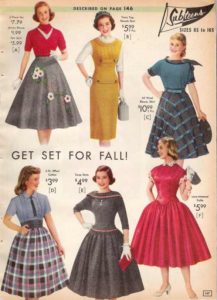
Dark Cottons were a necessity for every woman, schoolgirl, and matron in the South. Plaids and solids in heavier fabrics were worn, no matter the temperature.
Labor Day arrives in a few days. Now it’s a time to get one more day at the lake or pool, a respite before football season, the State Fair, and Thanksgiving. No more three-day weekends for a while. Labor Day arrives in a few days. Now it’s a time to get one more day at the lake or pool, a respite before football season, the State Fair, and Thanksgiving. No more three-day weekends for a while.
However, it wasn’t that way a few decades ago when Labor Day was a Red Letter Day. Women and girls put away white shoes and handbags, as well as straw hats and patent shoes. Fall began, and no self-respecting lady would be seen in summer attire, even if the temperatures were still in the high 90s. As late as the 1960s, fashion was the dictator of style, not the weather.
In the 1960s or 1970s Princess Margaret of Great Britain arrived the first full week of September in Houston clad in white pumps. Every woman in the state if not in the nation was aghast! Didn’t the Princess know it was time for Dark Cottons? Someone should have told her. But Margaret had a mind of her own and could care less. It was hot in Houston.
Dark Cottons were a necessity for every woman, schoolgirl, and matron in the South. In the North where the temperature began to dip, Dark Cottons were replaced with tweed skirts and jackets and woolen sweaters. High school girls and college co-eds lived by fashion codes found in Seventeen Magazine.
Dark Cottons were made of heavier cotton fabrics dyed in dark colors. The usual attire had a skirt (no pants on respectable ladies), a long-sleeved jacket, and a sweater or long-sleeved cotton shirt underneath. Stockings were requisite as were close-toed black or brown shoes, preferably with at least an inch heel. Accessories included a black or brown small handbag, a perky pillbox hat like Jackie Kennedy wore, and a strand of pearls. Jeans were relegated to the back of the closet, only to come out when no one was around.
The strict fashion guidelines were the result of World War II rations and Depression era lack of funds to foolishly spend on stylish clothing. Women were ready to think about new clothes. Department stores loved the new looks. Newspapers loved them also. Fashionable ads were constantly catching the eyes of well-dressed females. The new fall styles each year were just enough to make last year’s attire terribly dated.
Teenagers and co-eds weren’t the only stylish females in dark cottons. My mother and grandmother were exceptional seamstresses and always dressed me in the latest fashions, even as a first grader. I dearly remember a darling navy plaid dress they made me. I thought I was the best-dressed kid in school.
As you can tell, I lived in a small town where poverty could be seen not far from home. There were many children in my school not so well dressed. They rode the school bus for over an hour each way to school. While we think the 1950s and 1960s were so splendid for many they weren’t for everyone.
Thanks goodness, fashion styles are more democratic and less class based now.
